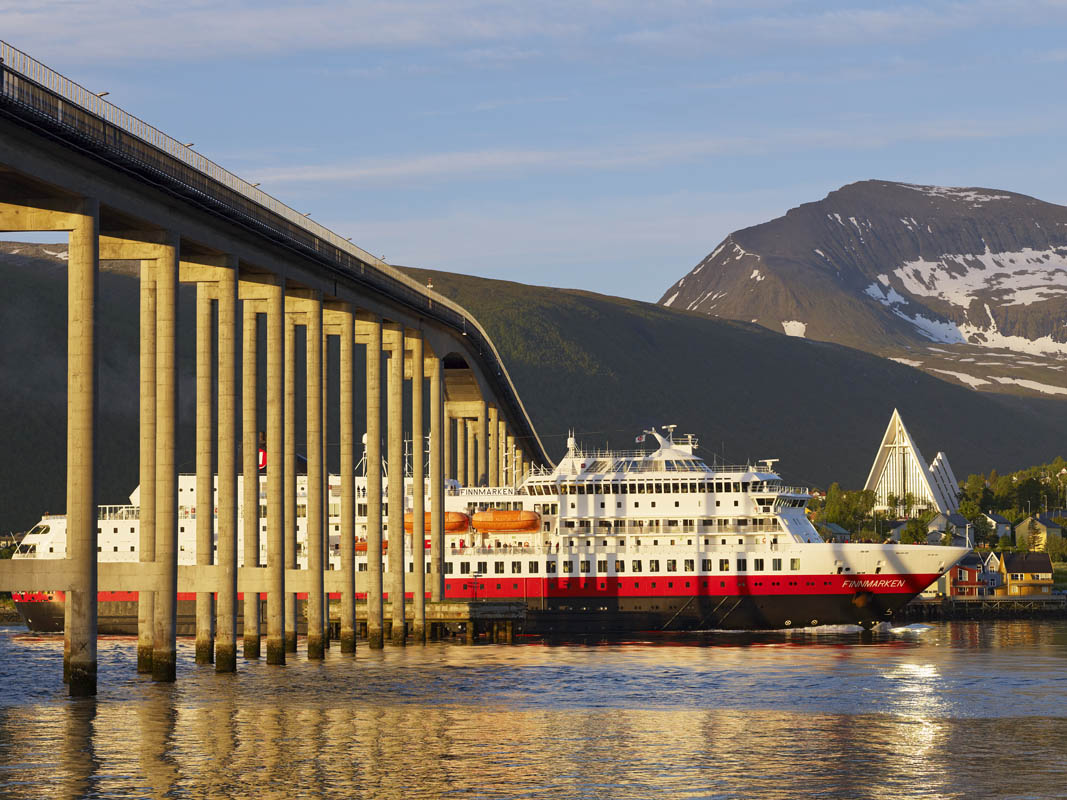Aurora is a lady who takes her time. The warmest and most comfortable way to wait for her is to sit in a cosy lounge on a Hurtigruten vessel. If she turns up, you’re guaranteed the best seat in the house!
Hurtigruten is one of the world’s great classic voyages, which most people choose to take in the summer. But the Hurtigruten ships sail all year round, and in winter they offer one of the most pleasant – and reliable – ways of seeing the Northern Lights. A trip by Hurtigruten is also a great way to travel between wonderful winter destinations in Northern Norway, and delivers its promise of stunning panoramic views of the winter landscape.
You can sail under Northern Lights oval
The routes plied by the Hurtigruten vessels follow the planet’s auroral oval, with the ships generally sailing well away from coastal towns and communities where there is light pollution. In Nordland and Troms, where settlements are quite scattered, porch lights and the lights from sitting room windows twinkle softly in the distance like a palely gleaming row of pearls along the water’s edge; while along the coast of Finnmark much of the voyage is in complete darkness. In other words, in this part of the world the light conditions for viewing the Northern Lights are the best possible.
Watching the aurora onboard is a cosy affair
The new generation of Hurtigruten vessels have top-deck lounges offering panoramic views. The typical Northern Lights watcher sits comfortably on the sofa with a cup of coffee and a warm jacket, hat and gloves to hand. On the bridge, the crew keep a lookout, and any glimpse of green in the sky is announced over the loudspeakers – the signal to jump up and go on deck to see the Northern Lights. The real pros even rig up their camera stands and are ready in seconds.
The ‘Blue’ hour can be seen from horizon to horizon
Even though the darkness may be the objective, the daylight is equally well worth experiencing. In the midst of the Polar Night, at the winter solstice, there is a surprising amount of light, even in the very far north. The southern sky is coloured like a sunset that never comes, in red, pinky-orange and gold. And then the magic “blue hour” arrives; the sky, the sea and the snow-clad mountains are stained a deep, transparent blue that is fabulously beautiful to behold. Even when it is completely dark, in clear weather the troll-like contours of the mountains are etched dramatically against the skyline.
The sun returns at the end of January, and in February and March the light is with us for many hours a day. As the afternoon progresses, the light falls in golden, reddish tints against the snow. Dusk is still deep blue, and the chances of seeing the Northern Lights in the evening are just as great as in December.
The Hurtigruten lifestyle allows for more than just sea views
Hurtigruten vessels call at some beautiful places along the northern coast, and are often in port long enough to permit a stroll on land. When the ship passes unusual mountain formations or sights of cultural or historical interest, an announcement is made over the loudspeakers. The ship’s tour leader organises interesting excursions, such as trips to the North Cape or snowmobile trips between Kjøllefjord and Mehamn.
There is a reason the Hurtigruten is named ‘the fast route’ in Norwegian.
If you are travelling independently to Northern Norway in the winter, the Hurtigruten is an extremely practical form of transport. It takes only four hours to sail from Bodø to the Lofoten Islands, and one night and one morning from the Lofoten Islands to Tromsø. Another night and you’re in Hammerfest and Honningsvåg by the North Cape. And one more night takes you to Kirkenes. There is usually plenty of room on board, so advance booking is usually not necessary.
You can step away from the outside world onboard
It is in the winter that the Hurtigruten really is the Hurtigruten. There is lots of room for relaxation in the ships’ lounges, and the passengers are mostly local people on their way between the small northern metropolises and coastal communities. Passengers can simply sit back and let Northern Norway sail past in the utmost peace and tranquillity. The typical feedback we get from guests is that they have never felt so relaxed.
Sometimes there can be Stormy weather
Dare you travel north in winter, though? Some of the very worst tales of storms you are likely to have heard do, of course, stem from Northern Norway: “…so he shook the tiles off the roof and shuffled them like a pack of cards…” (“he” being the weather… ), and such like. But now we’ll let you into a little secret; the worst weather is not in the far north compared with the North Sea coast, the weather in Northern Norway is relatively stable. And the Hurtigruten vessels generally follow a route fairly close to shore and away from the open sea. Most of them are also equipped with stabilisers which stop them rolling about too much. True enough, there can be some heavy seas, but far from the sort of thing that affects the entire trip. So how come you have heard so many storm tales from Northern Norway? Why, naturally, because the people of the north are the best liars and story tellers… Welcome on board
